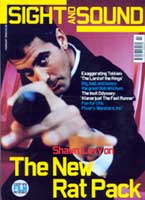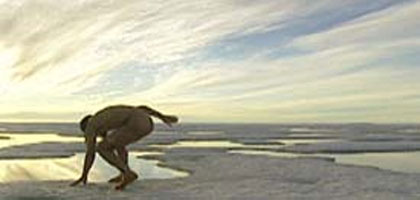
Northern Exposure

A fresh mythic story to rival Tolkien's epic arrives with Atanarjuat The Fast Runner, a low-budget digital film made in Arctic conditions by Canadian Inuit director Zacharias Kunuk. SF Said introduces an awesome film and talks to the director.
A hero is forced by harsh circumstance to leave his ordinary world. He finds a wise old teacher in the wilderness, passes perilous tests involving tricksters, shape-shifters and shadowy villains, then returns home to restore the natural order. Sound familiar? It's the classic mythic structure Joseph Campbell identified in his book The Hero with a Thousand Faces (1968), and ever since George Lucas ripped a page from Campbell in Star Wars (1977) it has become a Hollywood holy writ. There's even a how-to manual on the subject, The Writer's Journey (1992) by Christopher Vogler, that explicitly applies Campbell's work to screenwriting. It's required reading for Disney development executives - something that will surprise no one who's seen Aladdin (1992), The Lion King (1994) or Hercules (1997) - but the influence of this kind of thinking goes much wider. The universal appeal it promises rules the big budgets and the box office, and it's responsible for a seemingly endless string of attempts at modern myth-making from Gladiator (2000) to Harry Potter and the Philosopher's Stone (2001) and The Lord of the Rings: The Fellowship of the Ring (2001). Into this world comes Atanarjuat The Fast Runner. A film nearly three hours long, in the Inuktitut language, it may not displace these movies from the multiplexes, but it provides precisely the experiences their audiences are seeking. It is perhaps the purest, freshest burst of mythic narrative that cinema has produced in recent years, and when it swept through Cannes last summer like a blast of Arctic wind, winning the Camera d'Or for best first feature in the process, those who went with it were left whooping with exhilaration.
Atanarjuat feeds a hunger Hollywood's modern myths all too often leave unsatisfied. They look like the real thing, but for all their mastery of form, it's hard to avoid the suspicion that beneath their polished surfaces is a void where there should be instructive mythic content. Stories that have survived for millennia - such as the Mesopotamian Epic of Gilgamesh, or the legends of ancient Egypt and Greece - may take the shape of memorable narratives, but they use those narratives to encode deep cultural knowledge. They embody practices and philosophies of living appropriate to the environments in which they evolved. It's hard, by contrast, to see that a self-conscious piece such as DreamWorks' Shrek (2001) - despite its rigorous attention to structure - encodes much beyond its creators' disdain for, yet enduring emulation of, the Walt Disney corporation.
Atanarjuat is different. Like Gilgamesh or Homer's Iliad and Odyssey, it's the product of an oral culture: in this case that of the Canadian Inuit. The film is based on a legend that has been passed down from generation to generation for four millennia. The people who passed it down were nomadic hunter-gatherers, eking out their existence on the Arctic tundra near to what is literally the top of the world. The film's director, Zacharias Kunuk, now 44, was the first of his family to live in a permanent settlement - the community of Igloolik, population 1,200 - and he belongs to the first generation of Inuit to read, write and make films. In just one generation his culture has gone from oral storytelling to cinema: a leap that for European cultures is bridged by centuries of literature. This may help explain why Atanarjuat - an unmistakably authentic myth, which can be analysed using Campbell's framework - also contains all the density of mythic content, all the startling, satisfying roughness and strangeness modern myths typically miss out.
The story is set around Igloolik at an unspecified time in the past, before European colonisation. It tells of a community of Inuit who become divided by an evil shaman, and led astray by selfish leaders. Two brothers oppose this unbalanced order: Amaqjuaq the Strong One and Atanarjuat the Fast Runner. They constantly clash with Oki, the thuggish son of the community's leader, especially over the destiny of Atuat, a beautiful woman who loves and is loved by Atanarjuat but is betrothed to Oki. These clashes culminate in single combat between Atanarjuat and Oki: a ritual 'head-punching' in which combatants take strict turns to land single, smashing blows on each other's temples. Though weaker, Atanarjuat bests Oki - with assistance from the spirit world, depicted as accessible through shamanism - and so wins the right to wed Atuat.
Atanarjuat and his brother Amaqjuaq now establish a separate family with their wives, all sharing the same tent; but once Atanarjuat takes a second wife - Oki's trouble-making sister Puja - tensions rise, exploding when Puja has adulterous sex with Amaqjuaq. In the fracas that follows Puja returns to her own family, falsely claiming that Atanarjuat tried to kill her. This is what Oki has been waiting for. He and his henchmen fall murderously on Atanarjuat and Amaqjuaq in the tent where they sleep. Amaqjuaq the Strong One is killed, but Atanarjuat the Fast Runner - true to his name, and aided again by the spirit world - escapes. He flees, naked and barefoot, across the frozen Arctic sea, pursued by three men wielding deadly whalebone harpoons. In the film's most spectacular sequence, he leaps across a chasm in the ice which his pursuers cannot cross. Exhausted, his soles ripped and bleeding, frozen half to death, he finds his way to safety in the form of Qulitalik, an older shaman who left the community when the trouble began at the start of the story. With Qulitalik's help he heals himself and plans his return, to exact his own vengeance and restore order to the community.
The first thing that strikes one about this film is its vast scale. From the opening shot - a fur-clad man and his team of dogs out on the ice, tiny beneath a sky by which even the sun is dwarfed - its epic immensity is given visual expression through an awesome sense of place. But these stunning Arctic snowscapes, bathed in pink-blue northern light and filmed in breathtaking long shots, are not here simply to dazzle. Given the overwhelming significance of the environment in Inuit life, these images establish the context within which the myth's characters operate and in relation to which their deeds and values must be judged. They suggest, without words, the Inuit perspective on the proper relationship between humanity and the earth: one which requires respect, resourcefulness and inexhaustible patience.
The scale and harshness of the environment enforce proximity on human groups, and this too is reflected in the film's texture. Its interiors - igloos, tents and sod houses, lit with flickering seal-oil lamps - are as tightly packed as the exteriors are empty, the spaces between people highly charged. The boldest visualisation of this comes in the scene of Puja's adultery with Amaqjuaq. In one long, unbroken, static shot, taken from the front of the tent, two of the five sleeping heads that fill the screen draw surreptitiously closer and begin to move against each other with the unmistakable rhythms of sex. Nothing more is necessary to convey the violation of boundaries that is occurring and its potentially shattering implications.
Even in more routine scenes the camera gets so close to the action we can almost smell the caribou hides and walrus flesh, taste the snow melting on our tongues. The characters may be towering archetypes but they're also approachably human, people who piss and belch, and bleed when speared. Eliciting wonderfully spontaneous performances from a largely first-time cast and recording them with documentary-like precision, Kunuk and his collaborators - cinematographer/producer Norman Cohn and the late Paul Apak Angilirk, who wrote the script - have created a remarkably intimate epic. It perhaps reflects the film-makers' roots in observational video art but it also suggests the values that must operate in such tight groups - honesty, co-operation and patience - while illustrating what happens when they are overridden.
These positive values are constantly asserted in Atanarjuat's detailed depictions of Inuit life. There's an uncut three-minute sequence in which Atanarjuat calms his dog team on the edge of the frozen sea until the animals are quiet enough for him to walk away without fear of their bolting and leaving him stranded in the wilderness. The scene would most likely have been omitted or cut to three seconds by storytellers whose sole concern was keeping impatient consumers (and accountants) happy. But Atanarjuat is full of such sequences - demonstrating the proper preparation of sleds for Arctic travel, the cutting up of animal carcasses, the building of igloos - all using props and costumes handmade by local artists. Described in isolation they might sound prosaic, but harnessed to the compelling power of the mythic narrative, they add immeasurable depth to the story. This is especially true of the film's conception of shamanism, which includes reincarnation, communication with the dead and astral projection. Its nuances can easily be missed on a first viewing as it is presented with no fanfare or explanation. Magical shamanic acts are depicted simply and without comment; they are an integral part of the broad reality the film portrays.
Activities and values central to traditional Inuit culture thus shape the mythic content of the story. The foremost of them - calm, focused patience - is something receptive viewers can absorb and take away from the film. Viewing Atanarjuat for the first time is like being parachuted into Igloolik and left to fend for oneself. There's no scene-setting, no explicatory voiceover, none of the comforting crutches contemporary myth-makers often think their audiences need. Instead we're simply placed in close proximity to the characters, and invited to observe, attend, be open. The unhurried style of storytelling reflects the rhythms of Arctic life, as distinct from the accelerated pace of the industrialised world and its entertainments.
Atanarjuat, then, offers a fully realised vision of a complete, self-sufficient, singular culture whose practices and philosophies are embodied in the film's sense of time, space and action, all projected through the prism of a gripping myth. Yet its fundamental human concerns occupied our ancestors and occupy us still: finding food and shelter, keeping warm, getting on with each other. Even if some of the action will seem jarring to some audiences (bigamy, butchery), the cultural knowledge the film encodes is finally transcendent. By remaining true to content as well as to form, by representing idiosyncrasies without attempting to smooth them out for a global audience, Atanarjuat achieves something richer than universal box-office appeal. It makes us feel again as we did when we were children, wide-eyed in the dark, hearing one of the great stories for the first time: mythic visions that put new pictures in our heads, moved our hearts and changed the way the world looked ever after.
